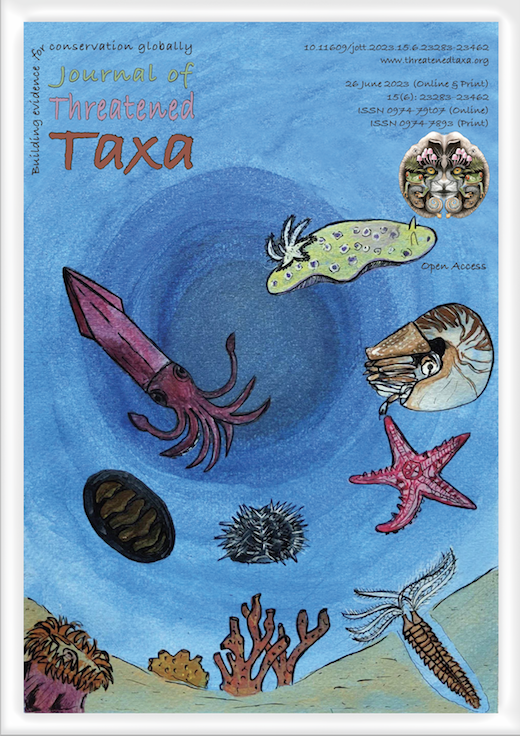Further photographic record of Asiatic Brush-tailed Porcupine Atherurus macrourus Linnaeus, 1758 (Mammalia: Rodentia: Hystricidae) from Manas National Park, Assam, India
DOI:
https://doi.org/10.11609/jott.5591.15.6.23446-23448Keywords:
Asiatic Brush-tailed Porcupine, camera trapping, conservation, Manas National Park, ethno-political conflictAbstract
For nearly two decades (1990–2010), conservation efforts in Manas National Park (MNP), Assam, India were compromised by ethno-political conflict. Documenting photographic evidence of rare species in MNP after the conflict is critical for informed conservation interventions. Asiatic Brush-tailed Porcupine Atherurus macrourus is one of the lesser-known mammals of southern and southeastern Asia, with populations declining throughout its range. During a camera-trap survey in MNP for Clouded Leopard Neofelis nebulosa, Asiatic Brush-tailed Porcupine was photo-captured.
References
Agrawal, V.C. (2000). Taxonomic Studies on Indian Muridae and Hystricidae: Mammalia, Rodenta. Zoological Survey of India, Kolkata, 177 pp.
Champion, H.G. & S.K. Seth (1968). A Revised Forest Types of India. Manager of Publications, Government of India, Delhi, 404 pp.
Choudhury, A. (2013). The Mammals of North-East India, first edition. Gibbon Books and the Rhino Foundation for nature in NE India, Guwahati, India, 432 pp.
Datta, A., M.O. Anand & R. Naniwadekar (2008a). Empty forests: large carnivore and prey abundance in Namdapha National Park, north-east India. Biological Conservation 141: 1429–1435. https://doi.org/10.1016/j.biocon.2008.02.022
Datta, A., R. Naniwadekar & M.O. Anand (2008b). Hornbills, hoolocks and hog badgers: long-term monitoring of threatened wildlife with local communities in Arunachal Pradesh, north-east India. Final report to the Rufford Small Grants Program (UK). Nature Conservation Foundation, Mysore, India, 80 pp.
Forest clearance (2013). Ngengpui Wildlife Sanctuary Biodiversity Repot. Ministry of Environment, Forest and Climate Change, Government of India, 9 pp.
Goswami, R. & T. Ganesh (2014). Carnivore and herbivore densities in the immediate aftermath of ethno-political conflict: the case of Manas National Park, India. Tropical Conservation Science 7(3): 475–487. https://doi.org/10.1177/194008291400700308
Jhala, Y.V., Q. Qureshi & A.K. Nayak (eds.) (2020). Status of tigers, co-predators and prey in India, 2018. National Tiger Conservation Authority, Government of India, New Delhi, and Wildlife Institute of India, Dehradun, 650 pp.
Kumar, R. & R. Kaul (2013). Management plan for Intanki National Park (2013–2018). Wildlife Trust of India, Dehradun, India, 116 pp.
Lahkar, D., M.F. Ahmed, R.H. Begum, S.K. Das, B.P. Lahkar, H.K. Sarma & A. Harihar (2018). Camera-trapping survey to assess diversity, distribution and photographic capture rate of terrestrial mammals in the aftermath of the ethnopolitical conflict in Manas National Park, Assam, India. Journal of Threatened Taxa 10(8): 12008–12017. https://doi.org/10.11609/jott.4039.10.8.12008-12017
Lahkar, D., M.F. Ahmed, R.H. Begum, S.K. Das & A. Harihar (2020a). Responses of a wild ungulate assemblage to anthropogenic influences in Manas National Park, India. Biological Conservation 243: 108425. https://doi.org/10.1016/j.biocon.2020.108425
Lahkar, D., M.F. Ahmed, R.H. Begum, S.K. Das & A. Harihar (2020b). Inferring patterns of sympatry among large carnivores in Manas National Park–a prey‐rich habitat influenced by anthropogenic disturbances. Animal Conservation 24(4): 689–601. https://doi.org/10.1111/acv.12662
Mallick, J.K. (2012). Mammals of Kalimpong Hills, Darjeeling District, West Bengal, India. Journal of Threatened Taxa 4(12): 3103–3136. https://doi.org/10.11609/JoTT. o2418.3103-36
Molur, S. (2020). Atherurus macrourus (amended version of 2016 assessment). The IUCN Red List of Threatened Species 2020: e.T2354A166518819. https://doi.org/10.2305/IUCN.UK.2020-1.RLTS.T2354A166518819.en [Accessed 29 April 2022].
Molur, S., C. Srinivasulu, B. Srinivasulu, S. Walker, P.O. Nameer & L. Ravikumar (2005). Status of South Asian non-volant small mammals: conservation assessment and management plan (CAMP) workshop report. Zoo Outreach Organization/CBSG-South Asia, Coimbatore, India, 618 pp.
Talukdar, N.R., P. Choudhury & B. Singh (2019). Current records of porcupine in northeast India: distribution, habitat preference and conservation. Tropical Ecology 60: 41–51. https://doi.org/10.1007/s42965-019-00005-4
Wikramanayake, E.D., C. Carpentert, H. Strand & M. McKnight (2001). Ecoregion-based conservation in the Eastern Himalaya. Identifying important areas for biodiversity conservation. World Wildlife Fund (WWF), Kathmandu, Nepal and International Centre for Integrated Mountain Development (ICIMOD), Lalitpur, Nepal, 140 pp.
Published
Versions
- 26-06-2023 (2)
- 26-06-2023 (1)
Issue
Section
License
Copyright (c) 2023 Urjit Bhatt, Bilal Habib, Salvador Lyngdoh

This work is licensed under a Creative Commons Attribution 4.0 International License.
Authors own the copyright to the articles published in JoTT. This is indicated explicitly in each publication. The authors grant permission to the publisher Wildlife Information Liaison Development (WILD) Society to publish the article in the Journal of Threatened Taxa. The authors recognize WILD as the original publisher, and to sell hard copies of the Journal and article to any buyer. JoTT is registered under the Creative Commons Attribution 4.0 International License (CC BY), which allows authors to retain copyright ownership. Under this license the authors allow anyone to download, cite, use the data, modify, reprint, copy and distribute provided the authors and source of publication are credited through appropriate citations (e.g., Son et al. (2016). Bats (Mammalia: Chiroptera) of the southeastern Truong Son Mountains, Quang Ngai Province, Vietnam. Journal of Threatened Taxa 8(7): 8953–8969. https://doi.org/10.11609/jott.2785.8.7.8953-8969). Users of the data do not require specific permission from the authors or the publisher.
Funding data
-
Science and Engineering Research Board
Grant numbers EMR/2015/000085





